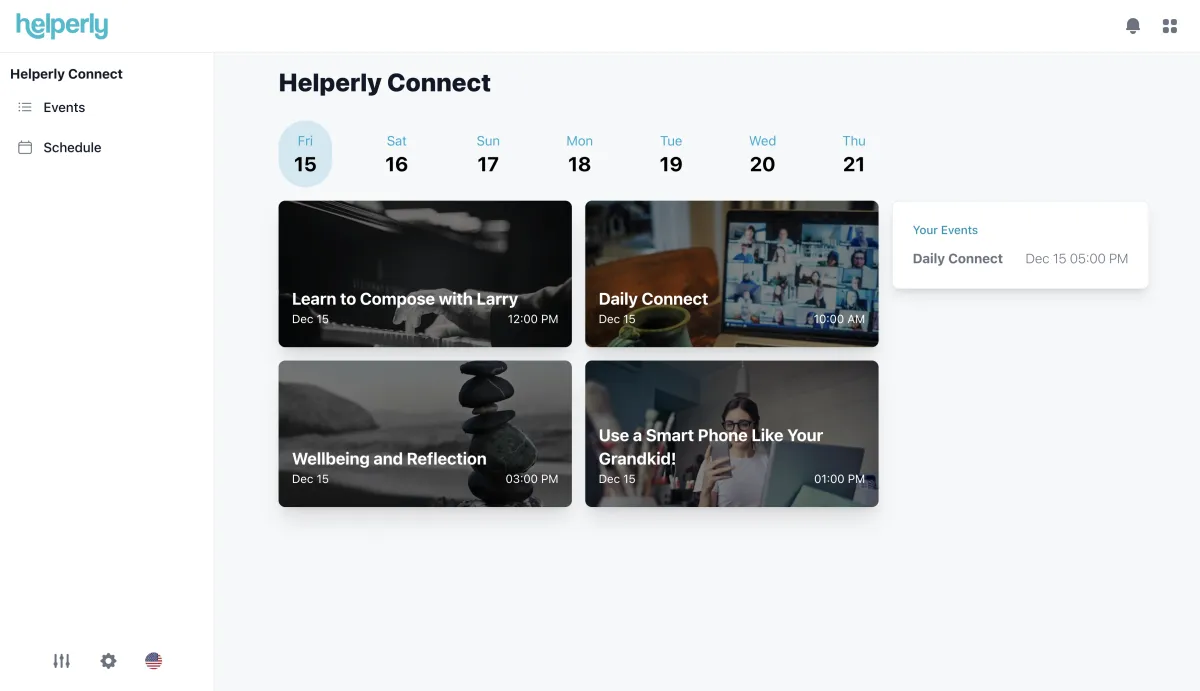Get a Torrential Downpour Of New Clients For Your Senior Care Business
Guaranteed results or you don't pay.


The Senior Care Academy Podcast
Learn From Industry Leaders
Lead Generation
You host activities on our activity platform and whoever attends your class is YOUR exclusive lead, no questions asked.


Auto Lead Nurture Sequence
When they attend the class you host, you have access to their information which enables you to send nurture sequences out. You'll have access to automated and optimized sales conversion tools to eventually enable the to book a consultation with you so you can get more clients.
Prospect Retention & Newsletter
Only 20% of newsletters get opened on average, and that's because they're BORING. We create engaging and converting newsletters for you so you stay top of mind, and have "raving" clients who stay with you forever.

Latest Blog Posts

Understanding and Addressing Employee Burnout in Healthcare
"Resilience is not about overcoming the impossible, but about finding strength within to endure and thrive."- Unknown
Introduction:
In the demanding world of healthcare, employee burnout has become an increasingly urgent issue that threatens the well-being of healthcare professionals and the quality of care they provide. Long hours, emotional strain, and heavy workloads contribute to a burnout epidemic that can lead to serious consequences for both staff and patients.
This article explores the root causes of burnout in the healthcare sector and offers practical, evidence-based strategies for prevention and intervention. By understanding these factors and implementing effective solutions, healthcare leaders can create a more supportive and sustainable work environment.

Understanding and Addressing Employee Burnout in Healthcare
Introduction
Employee burnout in healthcare is a growing concern that demands urgent attention. The healthcare sector is synonymous with high-stress environments, long hours, and emotional strain, all of which contribute to the epidemic of burnout among healthcare professionals. This article delves into the root causes of burnout, explores its implications, and offers evidence-based strategies for prevention and intervention. Our aim is to provide healthcare leaders with actionable insights to foster a supportive and sustainable work environment.
The Root Causes of Burnout
1. Workload and Hours
Healthcare professionals often work grueling hours under intense pressure. According to the American Medical Association, nearly 50% of physicians experience symptoms of burnout, largely due to the demanding nature of their work . Nurses, too, face similar challenges, with long shifts and the constant need to be alert and responsive .
2. Emotional and Physical Strain
The emotional toll of patient care cannot be overstated. Healthcare workers frequently encounter traumatic situations, witness suffering, and make life-and-death decisions. This emotional burden, coupled with the physical demands of the job, leads to chronic stress and burnout .
3. Administrative Burdens
In addition to clinical duties, healthcare professionals often grapple with administrative tasks. Documentation, compliance with regulations, and managing electronic health records can be overwhelming, detracting from patient care and contributing to burnout .
4. Lack of Support and Resources
A supportive work environment is crucial in mitigating burnout. Unfortunately, many healthcare settings lack adequate support systems, such as mental health resources, peer support programs, and sufficient staffing levels. This deficiency exacerbates feelings of isolation and stress .
Implications of Burnout
Burnout has far-reaching consequences for both healthcare professionals and patients. For healthcare workers, burnout can lead to mental health issues such as depression and anxiety, substance abuse, and even suicidal ideation . For patients, the repercussions include reduced quality of care, increased medical errors, and lower patient satisfaction .
Strategies for Prevention and Intervention
1. Fostering a Supportive Work Environment
Creating a culture of support and open communication is essential. Healthcare organizations should prioritize mental health resources, peer support groups, and regular check-ins to address staff well-being proactively .
2. Implementing Flexible Scheduling
Flexible scheduling can alleviate some of the pressures of long hours and demanding shifts. By allowing healthcare professionals to have more control over their work schedules, organizations can help reduce stress and improve work-life balance .
3. Reducing Administrative Burden
Streamlining administrative tasks through the use of technology and delegating non-clinical duties to administrative staff can help healthcare professionals focus more on patient care and less on paperwork .
4. Providing Professional Development Opportunities
Ongoing training and professional development can empower healthcare workers, enhance job satisfaction, and reduce burnout. Programs that focus on resilience, stress management, and leadership skills are particularly beneficial .
5. Promoting Self-Care
Encouraging healthcare professionals to prioritize self-care is crucial. This includes regular physical exercise, sufficient sleep, healthy eating habits, and mindfulness practices. Organizations can support this by providing wellness programs and promoting a healthy work-life balance .
How Helperly Can Help
If your healthcare organization is experiencing challenges related to employee burnout, Helperly is here to assist. Helperly specializes in providing innovative solutions and resources designed to support healthcare professionals and enhance workplace well-being. Our platform offers tools for flexible scheduling, streamlined administrative processes, and professional development opportunities tailored to the unique needs of the healthcare sector. By partnering with Helperly, you can empower your team, reduce burnout, and improve overall job satisfaction. Book a demo with Helperly today to discover how we can help you create a healthier, more supportive work environment for your healthcare professionals.
Conclusion
Addressing burnout in healthcare is not only a moral imperative but also a practical necessity to ensure the well-being of healthcare professionals and the patients they serve. By understanding the root causes and implementing targeted strategies, healthcare organizations can create a more sustainable and supportive environment, ultimately leading to better outcomes for all stakeholders involved.
References
American Medical Association. (2021). "Physician Burnout: Its Origin, Symptoms, and Five Main Causes." Retrieved from American Medical Association.
National Institute for Occupational Safety and Health. (2019). "Nurses: Physical and Emotional Stress." Retrieved from NIOSH.
Shanafelt, T. D., & Noseworthy, J. H. (2017). "Executive Leadership and Physician Well-being: Nine Organizational Strategies to Promote Engagement and Reduce Burnout." Mayo Clinic Proceedings, 92(1), 129-146.
Sinsky, C. A., et al. (2016). "Allocation of Physician Time in Ambulatory Practice: A Time and Motion Study in 4 Specialties." Annals of Internal Medicine, 165(11), 753-760.
West, C. P., Dyrbye, L. N., & Shanafelt, T. D. (2018). "Physician Burnout: Contributors, Consequences, and Solutions." Journal of Internal Medicine, 283(6), 516-529.
Mata, D. A., et al. (2015). "Prevalence of Depression and Depressive Symptoms Among Resident Physicians: A Systematic Review and Meta-analysis." JAMA, 314(22), 2373-2383.
Tawfik, D. S., et al. (2018). "Physician Burnout, Well-being, and Work Unit Safety Grades in Relationship to Reported Medical Errors." Mayo Clinic Proceedings, 93(11), 1571-1580.
Institute for Healthcare Improvement. (2017). "Creating Workforce Joy and Well-being." Retrieved from IHI.
American Nurses Association. (2020). "Addressing Nurse Burnout: The Role of the Workplace Environment." Retrieved from ANA.
Sinsky, C. A., & Bodenheimer, T. (2019). "Powering-Up Primary Care Teams: Advanced Team Care with In-room Support." Annals of Family Medicine, 17(4), 367-371.
West, C. P., et al. (2020). "Resilience and Burnout Among Physicians and the General US Working Population." JAMA Network Open, 3(7), e209385.
Epstein, R. M., & Krasner, M. S. (2013). "Physician Resilience: What It Means, Why It Matters, and How to Promote It." Academic Medicine, 88(3), 301-303.

Get Industry Secrets Weekly


